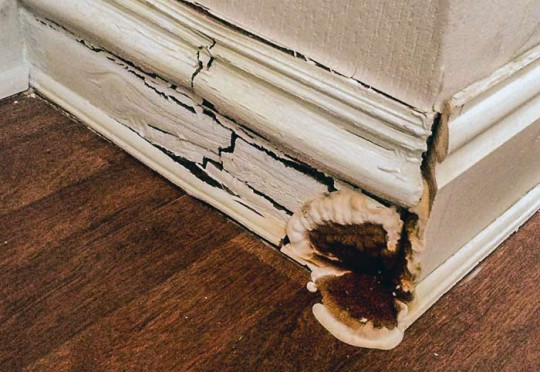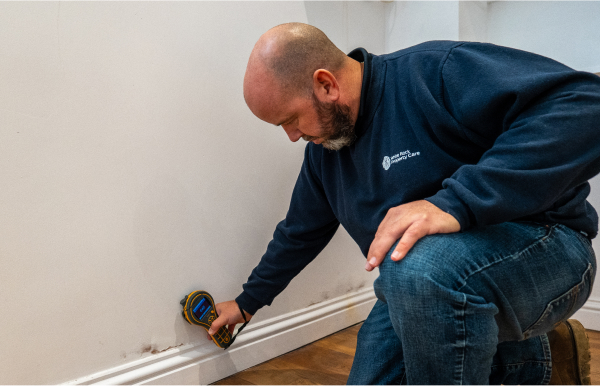Dry rot is a common term used to describe a very specific form of wood rot (Serpula Lacrymans). It is a wood destroying fungi/fungus which digests the part of the wood that gives it its strength and integrity. Depleting wood of such components leaves it in a brown brittle state, unsafe in any property.
Airborne spores land on damp timber and begin to germinate. If left to continue, white fungal growth will appear and strands will begin to form which will spread using the moisture and wood as their food source. A pancake shaped fruiting body will form and eventually explode, producing a mass of rust red airborne spores which will settle on timbers and so beginning the process again.
How to Identify Dry Rot
Dry rot has 4 different characteristics, depending the environment around it and the conditions within a property.
Mycelium Growth
Mycelium growth will appear as a white or grey cotton wool like substance. Mycelium has the ability to spread extensively across numerous building materials in search for a new source of food - in this case, wood.
Fruiting body (Sporophore)
The fruiting body or sporophore is easily identifiable with its ‘pizza-like or bracket’ appearance. These fruiting bodies can appear in an array of shapes and sizes dependant on the conditions present. Most of these round-shaped fruiting bodies are a rusty deep red colour (the spores) with the outer parts of this growth being a much lighter white colour. The spore dust from these fruiting bodies can be the first indication to a property owner that dry rot is present and a fruiting body is lurking somewhere nearby.
Affected Wood
As dry rot’s sole purpose is to dry out and remove moisture from the wood, a good indicator of a dry rot issue is the affected wood itself. This will look dried out and will have therefore shrunk as a result. This wood will most likely be brittle and warped and the grain of the wood will have cuboidal shaped cracking features.
Dry Rot Smell
The most common symptom of dry rot, even without physically seeing the outbreak, are the presence of a damp, musty and fungal smell. The smell may not necessarily mean there is a dry rot issue, but would certainly indicate an issue with dampness; however, dampness can often lead to dry rot depending on the extent of the issue.
How to treat Dry Rot
Our PCA accredited surveyors will look for the cause of the outbreak, investigating any damp conditions and will recommend and ensure the accurate treatment procedures are applied. They will evaluate all possible contributing factors and problems; reasons for the damp conditions, water ingress points, condensation, ventilation and signs of further wood rot and decayed timbers. Our Inspection Reports will contain recommendations for drying timbers where necessary and specifications and estimates for replacing timbers as required to prevent the spread of the rot.
Treatment solutions involve:
Elimination of all points of water ingress causing the damp conditions
Assessment for damp proofing and ventilation solutions
Removal and replacement of rotted timbers
Application of the appropriate fungicidal spray, timber pastes or dual purpose fungicide
Timber resin repairs ideal for sympathetic replacement of timbers in historical and listed buildings
If you’re concerned about the possibility of a dry rot outbreak in your property, or to request a survey, do not hesitate to get in touch with White Rock Property Care
Treatment is carried out by our teams of PCA trained technicians who have the skills and knowledge required to use the correct products, ensuring the rot and its spores are completely eradicated in both the short and the long term. The range of wood treating preservatives and biocides available to us are market leading and combine maximum effectiveness with minimal hazards to the Health and Safety of the buildings occupants and to the environment.



